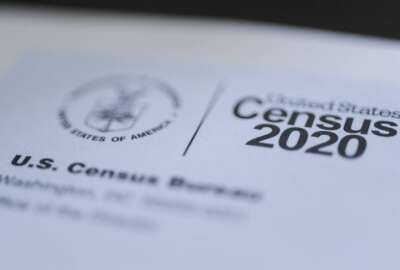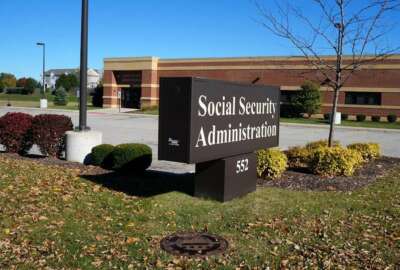Hubbard Radio Washington DC, LLC. All rights reserved. This website is not intended for users located within the European Economic Area.
VA seeks budget help to beat back backlog of disability claims appeals
The Veterans Affairs Department is requesting $20 million in fiscal 2016 to move its appeals processes from a mix of paper and electronic processes to only elec...
The Veterans Affairs Department is attacking its appeals backlog much in the same way it took on its disability claims backlog.
VA is using a combination of technology and process improvements to deal with an appeals backlog that has grown by about 15 percent over the last two years.
While VA has made a fair amount of progress dealing with its claims backlog, the appeals backlog has grown over the past year. It stands today at more than 285,000 and it takes on average more than 1,000 days to settle an appeals case.
Steph Warren, the VA chief information officer, said the department is asking for $20 million in fiscal 2016 to bring the appeals process well into the 21st century.
“Parts of it are in electrons and part of it is in paper. There’s an electronic tracking system that allows them to manage the work. It’s pretty much where the benefits processing was. There is a lot of paper,” said Warren during a conference with reporters Tuesday. “So when we talk about the investments in 2016 are to take Veterans Benefit Management System (VBMS) and the goodness that it brought to the benefits side and basically expand it into the appeals space. How do then as a result of an appeal being made on the benefits determination, how do we flow through into the next workflow and continue going forward? That’s why we asked for resources in 2016 to support that. There’s a lot of work taking place this year to look at the process improvements and how do we need to expose the capability out of VBMS to accelerate any transformation they need to make.”
The influx of money, people and new processes has made a big difference with the disability claims backlog. VA reports as of Feb. 21 that the total claims inventory is down to 489,000 from 883,000 in July 2012, and of those, 224,000 are part of the backlog, down from 611,000 as of March 2013.
Warren said the money to improve the appeals process is part of a $233 million increase in VA’s overall IT budget request. The department asked for $4.13 billion for technology for 2016.
VOIP pilots showing positive signs
Warren said 55 percent of that $4.13 billion goes for delivery of health care and services.
VA has the second largest IT budget in government behind the Defense Department, so that increase will go toward several programs.
One of its biggest projects is to replace its entire phone system with new voice over IP (VOIP) technology.
Warren said this is a 10-year program to replace 1,200 phone systems across the agency. VA started the effort with three pilots.
“It is moving from a fixed physical hardware plant to an internal cloud-based solution. It is VOIP. What we’ve done is we’ve set up the core capability at two data centers and what we do then is switch off those data centers to a private cloud to make sure we are able to do the VOIP on our backbone,” he said. “We did a lot of work on this to figure out what’s the best way to go. The answer was to be a government-owned, contractor-operated infrastructure and systems. That’s the pilots we are going through right now.”
Warren said Ft. Harrison in Montana has been up with the new phone system for about two months. He said the Tennessee Valley area is next to get the VOIP system, and then Charleston, West Virginia will follow later this summer.
He said the responses so far from the doctors and nurses at Ft. Harrison have been positive.
“We’ve been hearing just awesome comments about responsiveness is up, capability is up and we are able to integrate some of the things that the health care providers needed such as distress calls, emergency notifications and nurse notifications because a lot of that capability is baked into it,” he said.
Warren said one of the things they are finding as they move from the old private branch exchange (PBX) to VOIP is the different requirements the new technology needs that the old one didn’t. For example, VA must install uninterrupted power sources (UPS) in each VOIP switch closet because if the power goes down because of a hurricane or storm or for any reason, then the phones go down too without a UPS.
Scheduling system making progress
A second big priority is around the scheduling system.
Part of VA’s troubles last summer was its scheduling system because it was poorly designed and hard to use.
VA is taking a multi-pronged approach to fixing the scheduling system.
“We had the defects or the things that were identified that needed to be fixed in the existing software, we’re on the last one. There have been 11 patches that have been released and we are doing the last one so there will be 12,” Warren said. “The second one was the near term release to put the capability in place that changed the interface — moving away from roll and scroll to something that is easier to use. That gets done May 15. We are doing enhancements to existing software so this is expanding on what’s there. That contract was awarded last year. We continue to work on that. Capability is rolling out, in terms of some of the initial capability in April of this year as we continue to roll through that.”
VA issued a request for proposals in November to build a new patient scheduling system that could be worth as much as $690 million over seven years.
Warren added he expects to have a sense of their plans by the end of April, which could mean VA will make an award, though Warren didn’t say that was imminent.
Cyber budget increases
The agency also wants to give cyber a pretty big spending boost too in 2016.
Warren said he hopes the budget will be $30 million in the cyber account and an additional $30 million in the operational account. But he said that’s not all the money going for cyber. He said there is money for people and embedded cyber throughout the IT budget.
So in all, Warren said VA will spend about $53 million on cybersecurity as a program, $70 million for its network operations center, $30 million for the continues readiness and information security (CRIS) program and finally another $10 million for privacy and records management.
Warren said the money for cyber will cut across multiple programs and plans.
“This year we have significant investment going through how our domains are structured and how Active Directory is structured to make sure we’ve added some of the latest thinking on how you protect things,” he said. “Another one the team is working through, and I think it will be done by May this year, is requiring two-factor authentication or two factors when you log-in to a government computer from outside of VA. We’re constantly adding things to what we require of individuals with respect to blocking websites, blocking types of traffic and monitoring particular things. We are connected and expanding on it.”
One of the reasons VA is focusing on cybersecurity is the heat it is receiving from Capitol Hill. The agency came under pressure from the House Veterans Affairs Committee and its inspector general about network weaknesses that allowed at least eight nation state attacks starting in 2010.
Warren commissioned a report from cybersecurity firm Mandiant and released the initial results in January, showing the agency’s network to be in better shape.
He said the full public report from Mandiant continues to go through the clearance and redaction processes.
Another initiative Warren is in the middle of is visiting the VA’s field offices. He said VA launched the MyVA Idea House in November asking employees for ideas and innovations. Warren said recently he received one idea around cybersecurity during a visit.
“We actually got into a really good conversation about patching strategy and patching approaches. It was great to hear insights about how do we do a better job of that. In some cases the way we do patching is you do patch, patch, patch, patch, patch. One of the folks said, ‘You know what, instead of just patch, patch, patch, patch, patch, which has an overhead, let’s just drop a new image that is fully patched,'” he said. “So that’s something the team is fully exploring as a productivity improvement instead of as you normally do add a patch, restart, add a patch, restart, add a patch. It’s basically build an image, test it with all of the most recent patches on it and for places where there is no data resident on a computer, just go ahead and reimage the machine and the productivity improvement that we think can come from that is pretty significant..”
Warren added his team is trying to figure out how best to segment the laptops and desktops to apply this strategy.
Warren said the recent JASBug virus is an example of the patch, patch, patch, where they got an alert and have been patching ever since. He said VA is about 80 percent done and should be finished the other 20 percent this week.
RELATED STORIES:
Independent assessment gives VA’s cybersecurity positive mark
IT budget request rises to $86B, including $105M digital services
VA to spend $60 million more on cyber after auditors’ continued concerns
Copyright © 2024 Federal News Network. All rights reserved. This website is not intended for users located within the European Economic Area.
Jason Miller
Jason Miller is executive editor of Federal News Network and directs news coverage on the people, policy and programs of the federal government.
Follow @jmillerWFED





